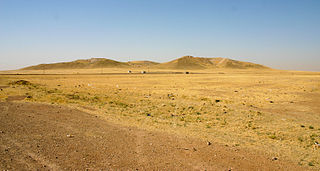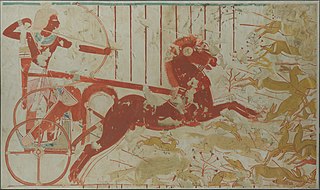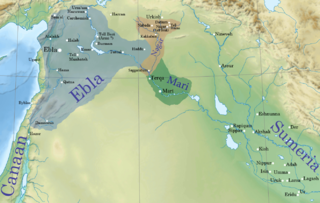| Isar-Damu | |
|---|---|
| King of Ebla | |
| Tenure | c. 2340 - c. 2305 BC |
| Predecessor | Irkab-Damu |
| Successor | Possibly Ir'ak-Damu |
| Died | c. 2305 BC |
| Spouse | Tabur-Damu [1] |
| Issue | Ir'ak-Damu Tagris-Damu [2] |
| Father | Irkab-Damu |
| Mother | Dusigu |
Isar-Damu (died c. 2305 BC), [3] was the king (Malikum) of the first Eblaite kingdom. Isar-Damu fought a long war with Mari which ended in Eblaite victory; he was probably the last king of the first kingdom.
Isar-Damu succeeded his father Irkab-Damu as a young child; his mother, Dusigu, seems to have taken advantage of her position as her husbands favorite wife and her probable familial relation to the powerful vizier Ibrium in order to elevate her son to the throne, despite him being one of Irkab-Damu's youngest sons. [4]
The first years of Isar-Damus's reign were dominated by his mother and the vizier; texts from Ebla show that Isar-Damu's name appeared on official documents after that of his mother. [5] Ibrium was the commander of the army and he conducted multiple campaigns against rebellious vassal-rulers or neighboring kingdoms. [6]
Isar-Damu concluded an alliance with Nagar and the relations progressed toward a dynastic marriage between princess Tagrish-Damu, Isar-Damu's daughter, and prince Ultum-Huhu, Nagar's monarch's son. [7] [8] In year seven of Ibrium's term, Nagar was defeated by Mari, causing the blockage of trade routes between Ebla and southern Mesopotamia via upper Mesopotamia. [9]
Ibrium became vizier two years prior to Isar-Damu's reign and kept his office for 20 years, dying in Isar-Damu's 18th regnal year; [6] [10] three years later, queen mother Dusigu died. [11] Following Ibrium's death, an Eblaite campaign was sent against Alalakh. [12] Isar-Damu concluded an alliance with Nagar and Kish against Mari, [13] and the campaign was headed by the Eblaite vizier Ibbi-Sipish, Ibrium's son, who led the combined armies to victory in a battle near Terqa. [14] Afterwards, the alliance attacked the rebellious Eblaite vassal city of Armi. [15]
Isar-Damu ruled 35 years, [16] and his main wife was Tabur-Damu but his crown prince Ir'ak-Damu was his son by an earlier consort whose name is unknown. [11] Although Isar-Damu is generally considered Ebla's first kingdom last monarch, his son Ir'ak-Damu, who was married to Za'ase, Ibbi-Sipish's daughter, [4] might have succeeded him for a short period. [17]
| Ancestors of Isar-Damu | ||||||||||||||||||||||||||||||||||||||||||||||||||||||||||||||||||||||||||||||||||||||||||||||||||||||||||||||
|---|---|---|---|---|---|---|---|---|---|---|---|---|---|---|---|---|---|---|---|---|---|---|---|---|---|---|---|---|---|---|---|---|---|---|---|---|---|---|---|---|---|---|---|---|---|---|---|---|---|---|---|---|---|---|---|---|---|---|---|---|---|---|---|---|---|---|---|---|---|---|---|---|---|---|---|---|---|---|---|---|---|---|---|---|---|---|---|---|---|---|---|---|---|---|---|---|---|---|---|---|---|---|---|---|---|---|---|---|---|---|
| ||||||||||||||||||||||||||||||||||||||||||||||||||||||||||||||||||||||||||||||||||||||||||||||||||||||||||||||

Ebla was one of the earliest kingdoms in Syria. Its remains constitute a tell located about 55 km (34 mi) southwest of Aleppo near the village of Mardikh. Ebla was an important center throughout the 3rd millennium BC and in the first half of the 2nd millennium BC. Its discovery proved the Levant was a center of ancient, centralized civilization equal to Egypt and Mesopotamia and ruled out the view that the latter two were the only important centers in the Near East during the Early Bronze Age. The first Eblaite kingdom has been described as the first recorded world power.

Mari was an ancient Semitic city-state in modern-day Syria. Its remains form a tell 11 kilometers north-west of Abu Kamal on the Euphrates River western bank, some 120 kilometers southeast of Deir ez-Zor. It flourished as a trade center and hegemonic state between 2900 BC and 1759 BC. The city was built in the middle of the Euphrates trade routes between Sumer in the south and the Eblaite kingdom and the Levant in the west.
Irkab-Damu was king (Malikum) of the first Eblaite kingdom, whose era saw Ebla's turning into the dominant power in the Levant.
Ibrium, also spelt Ebrium, was the vizier of Ebla for king Irkab-Damu and his successor Isar-Damu.
Ibbi-Sipish or Ibbi-Zikir was the vizier of Ebla for king Ishar-Damu for 17 years. He was the son of his predecessor, Ibrium, who had been Ishar-Damu's vizier for 15 years.

Tell Brak was an ancient city in Syria; it is one the earliest known cities in the world. Its remains constitute a tell located in the Upper Khabur region, near the modern village of Tell Brak, 50 kilometers north-east of Al-Hasaka city, Al-Hasakah Governorate. The city's original name is unknown. During the second half of the third millennium BC, the city was known as Nagar and later on, Nawar.

The Maryannu were a caste of chariot-mounted hereditary warrior nobility that existed in many of the societies of the Ancient Near East during the Bronze Age. Maryannu is a Hurrianized Indo-Aryan word, formed by adding Hurrian suffix -nni to Indo-Aryan root márya, meaning "(young) man" or a "young warrior". Philologist Martin West suggested that the name Meriones, a character in Homeric epic, is "identical" to maryannu. Thus, Mērionēs would be the Homeric Greek version of the term, reflected in pre-Mycenaean poetic verse as Mārionās.
Tudiya or Tudia was according to the Assyrian King List (AKL) the first Assyrian monarch, ruling in Assyria's early period, though he is not attested in any known contemporary artefacts. He is listed among the “seventeen kings who lived in tents.” His existence is unconfirmed archaeologically and uncorroborated by any other source. According to the list, Tudiya was succeeded by Adamu.
Armi, was an important Bronze Age city-kingdom during the late third millennium BC located in northern Syria, or in southern Anatolia, Turkey, at the region of Cilicia.
Vizier, is the title used by modern scholars to indicate the head of the administration in the first Eblaite kingdom. The title holder held the highest position after the king and controlled the army. During the reign of king Isar-Damu, the office of vizier became hereditary.
Iblul-Il was the most energetic king (Lugal) of the second Mariote kingdom, noted for his extensive campaigns in the middle Euphrates valley against the Eblaites, and in the upper Tigris region against various opponents, which asserted the Mariote supremacy in the Syrian north.
Kun-Damu was a king (Malikum) of the first Eblaite kingdom ruling c. 2400 BC. The king's name is translated as "Arise, O Damu". Kun-Damu is attested in the archives of Ebla dated two generations after his reign. According to Alfonso Archi, he was a contemporary of Saʿumu of Mari. The archives of Ebla records the defeat of Mari in the 25th century BC, and based on the estimations for his reign, Kun-Damu might be the Eblaite king who inflicted this defeat upon Mari. Aleppo might have came under the rule of Ebla during his reign. Following his death, he was deified and his cult was attested in Ebla for at least 30 years after his reign.
Sagisu was a king (Malikum) of the first Eblaite kingdom ruling c. 2680 BC. The king's name is translated as "DN has killed".
Abarsal was a city-state of Mesopotamia in the area of the Euphrates. Very little is known of the history of the town and the site is unidentified at the moment. It could be the city of Aburru mentioned in various texts of the tablets of Mari, which was located south of Emar to Qalat Gabir. A second theory says that could be Apishal.

Igrish-Halam or Igriš-Halab was a king of the ancient city state of Ebla. His name means "(The god of) Halab has driven away ", hence, the name might be a commemoration of an Eblaite victory that led to the incorporation of lands beyond the city of Halab.
Ib'al was the name used by Ebla in the 24th century BC to indicate a confederation of tribes occupying the steppic region south of Ebla; the region included small villages and towns. Qatna could have been one of the urban centers in the region.
Kura was a god worshiped in Ebla in the third millennium BCE. He was the tutelary god of the city, as well as the head of the local pantheon. While his functions are difficult to ascertain, it is well attested that he was connected to the institution of kingship.
{{cite journal}}: Cite journal requires |journal= (help)